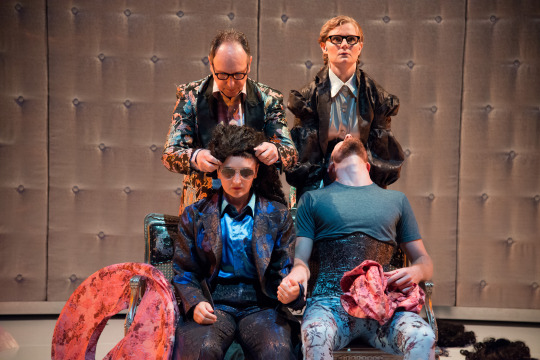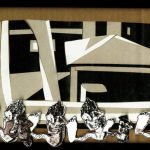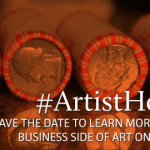Conversations | Annie-B Parson and “17c”
The three-time NYSCA/NYFA Artist Fellow discusses her latest production with Big Dance Theater.
The prolific Annie-B Parson (Fellow in Choreography ‘00, 06, ‘13) has choreographed and co-created more than 20 dance/theater works for Big Dance Theater, the award-winning company she co-founded with Paul Lazar in 1991. Outside of Big Dance Theater, she’s choreographed for operas, pop stars, television, movies, theater, ballet, and symphonies and worked with artists including David Byrne, David Bowie, and St. Vincent. Her latest Big Dance project, which she conceived, choreographed, and directs, will premiere next month in New York as part of Brooklyn Academy of Music (BAM)’s 2017 Next Wave Festival. Titled 17c, the production is century-spanning multidisciplinary conversation between the diaries of famed 17th-century philanderer Samuel Pepys, the radical feminism of 17th-century playwright Margaret Cavendish, and the cult of online annotators at pepysdiary.com. We spoke with Parson in the lead-up to 17c’s premiere.
NYFA: You’ve mentioned in previous interviews that you typically start Big Dance Theater productions from literature. When did you first encounter the diary of Samuel Pepys? How did you decide to bring in the work of 17th century playwright Margaret Cavendish and the annotators at pepysdiary.com?
Annie-B Parson: I don’t know when I first encountered the diaries of Samuel Pepys, but I have had them by my bed for years and years. I first thought of using them for a piece about four years ago in frustration over the American lack of interest in theater and dance. My experience is that American audiences are a slim, elite portion of the population and that we have no tradition of performance, like the Eastern cultures and European cultures I had encountered as a performer and choreographer on tour. These diaries stem from a culture where theater and dance were prized and studied.
I was charmed and vindicated by how much Pepys valued learning to dance, going to the theater (he saw it as a vice he couldn’t quite quit), and daily singing and music classes. Audiences in Shakespeares’ time stood in the mud for hours watching plays. In the argument between the past is so different from contemporary life and people never change, it seemed here was a chronicle of a time when art mattered greatly, enough to live for and fight for, very unlike our own. And Pepys was eye-opening in how unusual he was for his time, not because he was a diarist, but because of his compulsive, plain spoken and uncensored writing—it reminded me of a Facebook page!
Dispensing with the flowery language of the day, he recorded every toothache, desire, aspiration, thrill and frill, as he rode, strode, groped, and danced through his days. And, much like our own constant social media updates, he needed to get everything down on paper or he felt lost; he possessed this same compulsion to assign a real-time meaning to his daily existence. His descriptions of his life are unbound by any moralizing or spiritual component; Pepys “keeps it real” and while he has a contemporary self-awareness, he is also totally emboldened by and oblivious to his power and his privilege over women—wholly a man of his time. This contradiction makes him fascinating to observe, interrogate, and challenge.
Pepys went to the theater all the time and I wanted to represent this part of life, but didn’t want to use a male voice. Searching for female playwrights was detective work; Margaret Cavendish came from an extensive search for a woman playwright that Pepys might have seen or known. And, I was thrilled to read her radical feminist works and to bring her perspective to the stage.

NYFA: Margaret Cavendish is characterized as a groundbreaking writer who worked in many genres. Are there similarities between you that drew you towards bringing her into the production?
ABP: Margaret Cavendish (aka Mad Madge) was a brilliant hyper-generative woman writer from the mid 17th century. Some consider her the first sci-fi writer; she wrote across many genres. In searching for a female voice amid the forest of male playwrights of that time, I eventually came to her writing. She was probably not produced at all in her time but self published some of her books without her husband’s knowledge. He was both a supporter and a roadblock to her work. In fact, in reading the play A Convent of Pleasure (which should be directed as a film by someone with the visual insight and playfulness of a Paolo Sorrentino) I came upon a footnote that explains that the Margaret Cavendish’s husband rewrote the ending. The play takes a sharp right turn at the end away from the radical feminist plot line and sadly creates a heteronormative finale to preserve the status quo, and silences the woman protagonist.
Cavendish has been virtually erased by history and is only now, 350 years after her time emerging. For the most part, the stories we know are told by men from a male perspective, and even the greatest women artists are often left off of the “lists.” If there is a connection between me and Madge it would be one I feel I share with many female choreographers who are more important than I am, a sense of erasure, of being left off of lists, not mentioned, not pictured, not featured.

NYFA: Can you walk us through how you begin to choreograph a piece like 17c?
ABP: The material for the choreography, for the most part, comes from outside the material I am exploring textually. For instance, I am not using 17th century dance in the piece. The dance material most often stems from a formal problem and is completely unrelated to the textual material. But strangely and very soon, these disparate materials begin to burrow and nestle without coaxing. It’s perhaps the work of the gods that movement is so flexible and porous. Or maybe this can be explained simply by saying that the body holds multitudes of meaning. Dance clings, winds, and refracts around the contexts it’s placed in. Because movement has properties that have prismatic meaning, properties like proximity and muscularity and scale, these elements can quickly reflect what is around them.
NYFA: You’ve also mentioned previously that “all artists want to create space for their audience-especially most choreographers.” How would you describe the space that you’ve created for 17c?
ABP: One of my life-long interests is to create a sort of arithmetic for the audience to solve for themselves. I am striving to create the right kind of space that the audience feels inspired to insert themselves into, to walk away with their own piece in a sense. For 17c, the space may include physical and intellectual ideas around how we treat each other, where the female voice lives in history, and the strangeness of the self. In addition, from a formal perspective, the space is about how the primary elements of dance and theater co-exist and how they affect each other. As my work rejects notions of articulated content, I cannot answer the tired question: “What does this piece mean?” This is the work of the audience. But I am hoping the piece resonates in the precious imaginative, kinetic space in our minds and bodies.

NYFA: How might this production vary from the other work you’ve conceived with Big Dance Theater? Has your approach to your work changed since the company’s founding in 1991?
ABP: Over the years I have become frustrated by dance-illiterate audiences feeling alienated by my work, because I believe the mingling of narrative and abstraction can be strenuous. So in this work I have absorbed that space completely by literally answering, in real time, what I assume the audience will be questioning. These explanations become a separate element in the work, one of an ironic authorial voice. This is new for me and it popped up very late in the 17c process, just as I was finishing the piece.
NYFA: You’re a three-time NYSCA/NYFA Artist Fellow. What does NYSCA/NYFA’s support mean to you?
ABP: Being a NYSCA/NYFA Artist Fellow is a like a loud-ringing cheer of support in the ring of one of the greatest artist-centric performance cities in the world. Like most awards, the money is an essential component, but equally essential is the embrace coming from such a sophisticated panel in the most competitive throng of applicants.
– Interview conducted by Amy Aronoff, Communications Officer
NYSCA/NYFA Artist Fellowships are administered with leadership support from New York State Council on the Arts with the support of Governor Andrew M. Cuomo and the New York State Legislature. The 2018 award cycle is now open, with applications accepted through January 24, 2018. Sign up for NYFA’s bi-weekly newsletter, NYFA News, to receive announcements about future NYFA events and programs.
Images, from top: Annie-B Parson (Fellow in Choreography ’00, ’06, ’13), Photo Credit: Ike Edeani and 17c Production Stills featuring Cynthia Hopkins, Aaron Mattocks and Elizabeth DeMent, and (clockwise from top L) Paul Lazar, Kourtney Rutherford, Aaron Mattocks, and Cynthia Hopkins, Photos Credit: Johanna Austin





